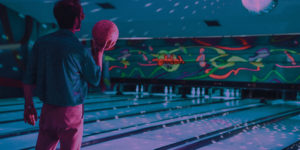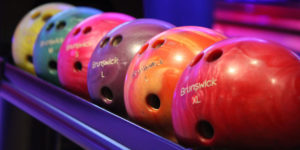
Bowling is one of the most popular games in the world, played by over 120 million people in more than 90 countries. There are thousands of bowling centers in the US alone, providing a place for young and old, big and small, experienced and inexperienced, to come together and knock down some pins. But where exactly did this game begin? What are the origins of such a fun and versatile sport? Let’s delve into the history of bowling, so that we can better understand the game we have all come to know and love.
An Ancient Past
It is quite possible that different initial forms of bowling may have begun at different times and in different places, as reports of its origins date back thousands of years at a time when records weren’t as well-kept as they are today. The true history of bowling is not a simple nor linear progression.
Let’s take it back to 3200 BC, in ancient Egypt. Though there are surely some differences between the game played then and the game that is played today, some of the oldest remnants of bowling paraphernalia–a crude form of pins and bowling balls– were found in a child’s tomb. This collection was discovered by British anthropologist Sir Flinders Petrie in the 1930’s. This find suggested that bowling, for the ancient Egyptians, may at first have been a game enjoyed by children.
The game can also be traced back to ancient Yemen, Germany, and Finland. In ancient Polynesia, players rolled disc-like balls of stone in a manner similar to modern-day bowling for the regional game called “Ulu Maika.” Various forms of bowling were also noted by Herodotus, an ancient Greek historian and geographer from the Greek city of Halicarnassus. According to him, bowling was an invention of the Lydians in Asia Minor.
In Germany, somewhere around 300-500 AD, bowling began to take shape into the game as we know it today. However, at the time it wasn’t used as a recreational game, but actually as a ceremonial ritual for church-goers. The pins represented evil spirits, and were knocked down by stone objects in the hopes that participants would cleanse their spirits and free their souls. In the case of a hit, the thrower was considered not to be a sinner. If the outcome was the opposite, then the parishioner was supposed to attend services more often.
The Evolution into Bowling as We Know It
There is substantial evidence that a form of bowling was popular in England in 1366, when King Edward III allegedly outlawed it to keep his troops focused on archery practice during the 100 Years’ War. And it is almost certain that bowling was popular during the reign of King Henry VIII in the 1500’s. At this point there were still numerous different ways to play the game, as there is evidence of bowling games played with as little as 3 pins, and as many as 17.
In 1819 American literature, we see a mention of bowling by Washington Irving in the short story “Rip Van Winkle.” In this story, Irving references bowling by telling a tale of a man who goes into the woods and is tricked into a 20-year slumber by a group of men drinking and playing “nine-pins.”
As time went on, bowling continued to develop and grow in popularity across Europe, where it was not unusual to see bowling greens at the estates of the wealthy. However, the game began to gain a bad reputation due to the associations with gambling and drinking. The American nine-pins game (named so because it was typically played with 9 pins) was no exception to this association with seedy activities. As a result, the game of nine-pins was banned completely in many places, including Connecticut and New York. To counteract this law, bowlers simply added another pin, turning the game into “10-pin bowling,” which had technically not yet been outlawed. This may have been the catalyst that created the 10-pin game we play today.
Despite the laws and attempts from the government to put a stop to bowling, the will of the people was stronger. Games continued to be played, often outside the main parts of the city to maintain more secrecy.
As German immigrants began to move westward, the game’s popularity continued to increase rapidly nationwide. That progress led to the formation of the American Bowling Congress in 1895 after the basic rules had been codified and equipment regulations got established. The first championship tournament was held in 1901.
Technological Advancements
As we moved into the progressive era in America’s history, many areas of bowling were also improved upon and enhanced at a rapid pace. Whereas bowling balls had been primarily wooden before, in 1905 the first rubber bowling ball was created called the “Evertrue.” A decade later in 1914, the Brunswick Corporation developed a new ball made of a material called “mineralite”. These bowling balls were one of the most durable consumer goods ever manufactured; it sold in the millions with a lifetime warranty, yet only a handful were ever returned as defective.
In 1952, the first “pin spotter” machine came about to reset the bowling pins on its own, relieving the position of the “pinboy.” Before this, a person called the “pinboy” would physically have to reset the pins after every turn.
Though rubber and mineralite bowling balls were produced well into the 1980’s, in 1959 a new invention took hold of the sport; the plastic/polyester bowling ball. Some plastic balls are still produced today, primarily used by children and beginners. The 1950’s brought upon additional bowling advancements, such as electronic scoring and monitors.
While the plastic bowling ball replaced the rubber bowling ball as the ball of choice on the Professional Bowlers’ Association tour in the 1970’s, some issues arose with the ball’s inefficiency in reacting to lane conditions. This problem was solved in the 1980’s with the introduction of balls with urethane finishes, and as bowling lanes were widely coated with a urethane finish as well. This gave bowlers a better overall hook potential despite requiring much more general maintenance (repeated use gummed up the ball’s pores with lane oil and reduced its overall effectiveness).
Urethane bowling balls are still widely used to this day, and they’re also the general base for the newest and most popular modern-day bowling ball advancement – the reactive resin bowling ball.
As the world continues to change, inevitably so will bowling. It is incredible to see how one sport can advance and improve over the years, and these improvements can only continue. While we can’t know for sure where bowling will be taken in the next 100 years, we do know one thing for certain; the world’s love for bowling will always be around.
SpareZ Bowling
Want to test out your new knowledge about the history of bowling on the lane? Come on down! Call us today at 954-434-9663 or fill out our online form with any questions or concerns. Here at SpareZ we are dedicated to great times and quality lane service!






